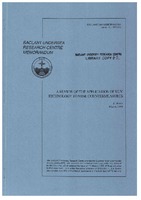| dc.contributor.author | Bovio, Edoardo | |
| dc.date.accessioned | 2018-10-11T14:08:54Z | |
| dc.date.available | 2018-10-11T14:08:54Z | |
| dc.date.issued | 1999/03 | |
| dc.identifier | 12205 | |
| dc.identifier.govdoc | SM-345 | |
| dc.identifier.uri | http://hdl.handle.net/20.500.12489/531 | |
| dc.description.abstract | The emphasis on littoral warfare, the proliferation of low cost mines available to potentially hostile countries, high exercise costs and risks related to the operation of present NATO MCM units, require the development of Unmanned Underwater Vehicles (UUV) capable of performing a variety of operational missions. UUV may be Autonomous (AUV), or remotely operated (ROV). The scope of this paper is to review UUV technology in the context of MCM. The operational aspects of future MCM are briefly addressed and a broad operational requirement for UUV is proposed. Underwater vehicles relevant to MCM are examined together with some of the military and scientific programs being undertaken in the different NATO nations. UUV technology is discussed and the performance that is likely to be achieved in the near future is outlined. UUV concepts of operation are technology limited in four important areas: navigation accuracy, communication bandwidth, robust autonomous mission control functionality and power system energy densities. Current advances in navigation are encouraging and good progress is being made in the development of compact effective navigation systems and in map based navigation techniques. Limitations in communication capabilities are being addressed by the use of fibre optic data links and by research into maximizing acoustic communication bandwidth and into advanced data compression techniques. The unfavourable underwater channel will however prevent high data rate acoustic transmission of information. High capacity, low cost data storage allows to complete some UUV missions without the need for on-line communication. The issue of achieving robust autonomous control for UUV is intimately connected with progress in UUV sensor technology. Recent developments have seen the fielding of intelligent navigation, guidance and control systems and intelligent on-line mission planning systems. The high cost of high energy density power systems is however limiting the realization of the more advanced UUV system concepts. The review shows that UUV have reached a sufficient level of development to be considered as candidates for future MCM operations. AUV in particular, have the potential to effectively perform missions which would not be possible, except at high risk, with present MCM assets. The rapid development of technology will overcome remaining limitations by the first decade of the next millemium when AUV will be an essential part of modem MCM systems. | |
| dc.format | vi, 56 p. : ill. ; 16 fig. | |
| dc.language | English | |
| dc.publisher | NATO. SACLANTCEN | |
| dc.subject | Autonomous Underwater Vehicles (AUV) | |
| dc.subject | Unmanned Underwater Vehicles (UUV) | |
| dc.subject | Mine countermeasures (MCM) | |
| dc.title | A review of the application of UUV technology to mine countermeasures | |
| dc.type | Scientific Memorandum (SM) | |
